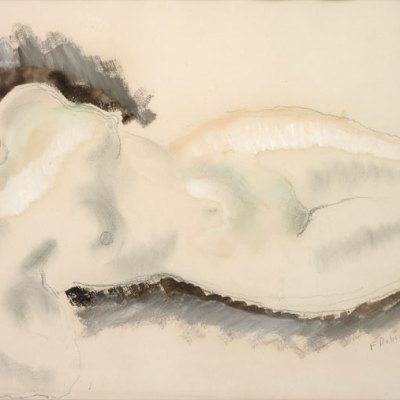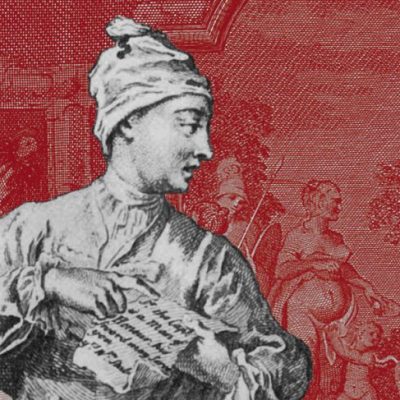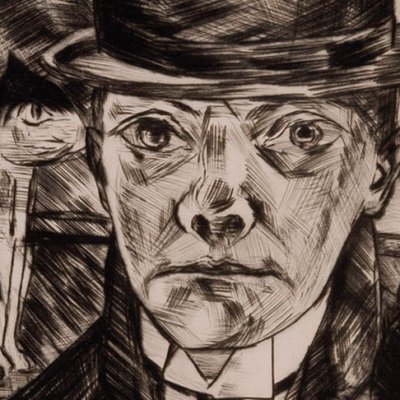On 29 April, ‘Eric Gill: The Body’ opens at the Ditchling Museum of Art + Craft in West Sussex. The exhibition will celebrate the sculptor’s art, but also promises to address those distressing details of Gill’s personal life, including his sexual abuse of his own daughters, that emerged in the 1990s. In an article for the May 2014 issue of Apollo (republished in full below), James Williams examined the impact that these revelations have had on public and scholarly attitudes to the sculptor’s work.
In the last years of the 20th century, a new appetite for iconoclasm seemed to be stirring in England. It’s an appetite, as readers of Apollo will know, that enjoys a long history. During the English Reformation, zealous Protestants sought to purify their cathedrals from superstition, smashing stained glass and sculpture, and whitewashing wall paintings. A century later, galvanised by parliamentary ordinances against idolatrous worship, troops ran riot in many towns, tearing down the High Church fixtures and fittings that had proliferated under the comparatively Anglo-Catholic Charles I (‘What beating down of walls! What tearing up of monuments!’, lamented the Bishop of Norwich in 1643). In 1998 a new wave of this movement seemed to be gathering momentum, albeit on a far smaller scale. A group of campaigners caught the attention of the media by seeking the removal (some also urging the destruction) of a set of Stations of the Cross from a cathedral in London. The offending Stations were in Westminster Cathedral, the most senior Roman Catholic church in England, and the focus of their anger was the artist Eric Gill (1882–1940).
Station IX from the Stations of the Cross (1913–18), Eric Gill. Westminster Cathedral, London

The Westminster Stations of the Cross, commissioned by the young Cathedral in 1913, the year Gill converted to Catholicism, were one of many sets the artist carved in his lifetime. They are remarkably lucid works which mediate religious feeling in a visual language that speaks of Gill’s most important concerns and convictions. The characteristically strong and structural sense of line is used to underscore both the doctrinal significance of the scene (‘all art is propaganda’, Gill believed) and to reinforce the communicative importance of human bodies.
In Station IX, the third time Christ falls on his way to Calvary, Gill divides up the panel with the shape of the cross extending in three directions outside the bounds of the pictorial space. It has fallen at an odd angle, too (in strong contrast to the second fall in Station VII) and the effect is to make the whole composition asymmetrical, flattened, geometric, almost japoniste. It’s momentarily disorientating, as a depiction of falling might well be. At the same time, the oddly angled lines of the cross are picked up and counter- pointed everywhere in the arms of the scene’s participants. The centurion’s hand continues, unmoved, to press the cross forward; Simon of Cyrene holds it impassively near the base, to give the brief moment’s relief needed for Jesus to stand again. Everywhere the visual logic is the logic of the cross, its dreadful dead weight, its different kinds of inertia and momentum. The exception is Christ’s bent back, the most powerful curve, halo excepted, in a composition full of angles.
The Raising of Lazarus (early 12th century), English. Chichester Cathedral

For Gill the virile power of the male body was a continued source of fascination, and in this moment of abject weakness, his depiction of Christ speaks of an unrealised strength. Unrealised, that is, because the scene conveys no drama: this is a panel full of potential energy, which isn’t trying to create the illusion of movement. Everything is cool, statuesque, as hard-edged and unemotional as the stone from which it has been carved.
In some respects it resembles the modestly unegoistic art of the medieval stonecutters whose reliefs in Chichester Cathedral the young Gill greatly admired. But whereas the Chichester stonework would have once been vividly painted, Gill’s reliefs are designed from their inception to be all but uncoloured, drawing attention to the artwork’s concrete materiality. The cool effect of (near) white figures on a (near) white background anticipates the emotional detachment Ben Nicholson would strive for in the 1930s with his white reliefs, and at the same time harks back to an imagined aesthetic of classical antiquity. Everywhere, the artwork speaks of its incarnation, the embodiment of its spiritual vision in the material world.
Another Gill conviction was the continuity of the stonecutter’s with the typographer’s art: his Latin text is not set apart in a corner or a panel, but jostles for space with the figures, punctuated by cross, helmet, spear. It comes from Micah: ‘Rejoice not against me, O mine enemy: when I fall, I shall arise; when I sit in darkness, the LORD shall be a light unto me.’
What drove the new iconoclasts of 1998 to urge for these works’ removal was not, as it had been for their predecessors, a matter of liturgy or doctrine. Their motivation was a belief about the morality of the artist – a creature, it seemed, more of the darkness than the light – and the relationship of the artwork to the ongoing suffering of living victims of abuse. Since Fiona MacCarthy’s biography of Gill in 1989, the artist’s polymorphous sexual life had come to be a matter of public consciousness. The list of Gill’s crimes and misdemeanours included a long-term incestuous relationship with his sister, Gladys, and a variety of obsessive sexual experiments, many of them recorded meticulously in his diaries. Not even the dog, it seems, was safe from Gill’s curiosity. The most powerful scandal, however, was the revelation that Gill had engaged in sexual behaviour with his pubescent daughters, behaviour which Gill seems to have viewed in the same spirit of fearless experiment, but which by anyone else’s definition would count as sexual abuse.
For Margaret Kennedy, the clerical abuse survivor who led the call for the removal of the Westminster Stations, here was a clear moral bottom line: ‘Survivors couldn’t pray at the Stations of the Cross. They were done by a paedophile.’ Kennedy’s campaign triggered heated exchanges in the letters pages of the British Catholic press. ‘Would someone in a position of authority in the Church…explain why we have the work of a paedophile in our churches?’ wrote one correspondent to the Catholic Herald, with another adding piously that ‘so much of his (other) art was pure pornography. Does that count for nothing?’
Of course other voices, Catholic and non-Catholic, were raised in equally passionate opposition. What was remarkable about the simmering controversy over the Westminster Stations was the dizzying view they afforded of an artistic reputation turned completely and abruptly on its head. In secular circles Gill’s stock was high enough. In the years since his death in 1940 he had become one of the acknowledged architects of modern British design, from his relief sculptures of Ariel on BBC Broadcasting House in the early 1930s and his designs for stamps of George VI, to his typefaces, which for decades shaped the visual style of publishing houses and imprints including Faber and Penguin. Gill was among the artists fêted by the establishment, who defined how Britain at the mid-century looked. In the intellectual milieu of British Catholicism, however, Gill was something more. Like Antoni Gaudí in Catalonia, he was rapidly canonised as a modern saint, a type of the heroic Catholic modernist.
Ariel between Wisdom and Gaiety (1933), Eric Gill. Photo: Mark Blower, 2012

A key figure in this process was Gill’s friend and disciple Donald Attwater. Editor of the Penguin Dictionary of Saints, and a revising editor of Butler’s Lives of the Saints, Attwater understood the power of hagiography: he was far from naive when, in his 1969 memoir A Cell of Good Living, he painted a picture of Gill as a kind of craftsman-saint for the 20th century. The title was a slogan from Gill himself, who wrote at the conclusion to his Autobiography (1940) that ‘the work which I have chiefly tried to do is this: to make a cell of good living in the chaos of our world.’ For Attwater, there was little doubt that Gill had succeeded. Gill’s life of rule and simplicity, work and prayer, was a saintly existence, a life of protest against a world of industrial capitalism. The series of Catholic arts and crafts communities that Gill founded in Ditchling in Sussex, Capel-y-ffin in Wales, and at Piggotts in Buckinghamshire, were for Attwater little glimpses of authentic sanctity in an increasingly secular world.
We might see Gill as a deeply flawed sinner striving for a religious equilibrium through his art, or less charitably as an abuser and a monster who tried to perpetrate a fraudulent image of holiness on his fellow men. Either way, his posthumous fate looks a lot like a cautionary tale about modernity, about a religious artist’s failure to be a saint in a world that can neither cultivate nor tolerate sanctity. Certainly the controversy over the Westminster Stations can be understood, on one level, as a product of particularly modern forces and circumstances. The immediate cause, as the campaigners saw it, was the scandal over clerical abuse of children within the Catholic Church, a scandal that would only grow over the following decades as the extent of the Church’s complicity in protecting abusers became clear. Growing public outrage over paedophilia, however, was not simply an issue for Catholics. After the murder in 2000 by Roy Whiting of the seven-year-old Sarah Payne, the News of The World launched a ‘name and shame’ campaign against paedophiles that quickly turned into a witch-hunt.
There is another view, however, in which the Westminster Cathedral controversy calls forth long echoes from the past, and that is the view that Gill himself took of his art: that of a Catholic thinker who cultivated a memory for the history of the church. From this long historical viewpoint, both the aspirations and failures of Gill’s work, and the controversies and debates they provoked, can be understood as contemporary echoes of ancient theological questions. Margaret Kennedy was quoted at the time of her campaign as saying that survivors could not pray with the Westminster Stations because ‘the very hands that carved the Stations were the hands that abused’.
Kennedy’s choice to focus on the hands, knowingly or not, recalls the Donatists of the fourth and fifth centuries, a schismatic group who believed that priests who had committed grave sins could no longer validly continue to celebrate the Mass. Christ simply would not become bread and wine in the hands of wicked men. The orthodox response to the Donatists was that the sacraments are validly performed ex opere operato, ‘by the doing of the work’, and not in virtue of the special moral goodness or merits of the doer. As if to press the point, the Canon of the Mass makes a point of focussing the worshipper’s attention on the hands at the moment of consecration, the priest’s hands, and behind them the hands of Christ who is really performing the act: ‘He took bread in his holy and venerable hands’.
Eric Gill had things to say about both work and hands. In a series of lectures in 1934, published as Work and Leisure, he offered his vision of the artist’s work as continuous with all making, and if not quite ex opere operato, then entirely dependent on divine aid, ‘a collaboration with God in creation’. Gill was an heir to Morris and the Arts and Crafts movement of the 19th century, and he took pride that his work was with his hands, lamenting ‘the efforts of merchants and inventors to supplant the hand by the machine’. For Gill, sculpture and draughtsmanship were extensions of the hand that was not divided from the mind or the heart, but which moved and felt along with them instinctively like the hands of a lover. The most urgent and recurrent metaphor for art, as for religion, was falling in love, and for Gill this was unimaginable except in relation to the physical act of sex. Gill’s fascination with sex, then, however selfishly and pathologically he pursued it, was in the end a fascination with the same fallen but redeemed bodily nature that was inseparable from his view of art. The challenge to separate the art from the man which faced the viewers of Gill’s Stations in 1998 turns out to be as deeply connected with the Donatists of the fourth century as with the tabloid press of the 20th.
Modern critics have tended to see Gill’s sexual life in direct contradiction with his religion. Insofar as it was unregulated, self-serving, and frequently exploitative, there is a straightforward sense in which this is undeniable. But for many of Gill’s modern commentators the conflict runs deeper. Fiona MacCarthy writes of Gill’s challenge to ‘Christendom’s traditional confrontation of matter and spirit’. Malcolm Yorke, in his monograph on Gill, goes further: Gill ‘over- selected, misread, or ignored, centuries of Christian history and art in which this dualism was obvious’. But like many things that are obvious, this is more complex than it first appears. Christian thinkers have certainly often opposed body and soul, sometimes advocating the mortification of the former for the salvation of the latter. But Christianity is also a religion whose central doctrine is anti-dualistic: the Incarnation, the Word made Flesh. In its early centuries, the Church fought fiercely against sects who wanted to reinterpret Christ’s divinity in such a way as to spare the Godhead the indignity of being wrapped up in the nastiness of flesh. Docetism, for example, a heresy that emerged around the end of the second century, held that Christ’s humanity was a kind of optical illusion perpetrated on humanity by God the master magician.
Divine Lovers (1926), Eric Gill. Courtesy of Harvard Art Museums

Among Gill’s slogans was that ‘it all goes together’. For Gill, ‘Man is matter and spirit, both real and both good’. The ‘pure pornography’ complained of by the correspondent to the Catholic Herald in 1998 was not only erotically explicit, but explicitly concerned with connecting the sacred and the sexual, to make the sexual act the most powerful symbol of the divine. In works like Divine Lovers: 1 (1922), Gill saw sanctity and sexuality as complexly intertwined, as the engraved lines overlapped and intertwined in complex loops in their ambling journeys across the page: and yet the final effect is not complexity but sublime simplicity. The nipples of Gill’s Divine Lovers are pressed together with something of the playfulness of Brancusi’s The Kiss (1907–08), but Gill’s is not an image of symmetry so much as different lovers (they might be read as God and the human) coming together in a union at once erotic and sacred. The pose might even look a little awkward, as in Klimt’s The Kiss (1908–09), but there is something creative and alive in their collision: this is, in Whitman’s phrase, the body electric. It is deeply troubling to recognise the same graphic style, the same delicate eroticism, in Gill’s portraits of his daughter Petra, given what we now know, or think we know, about what passed between them.
The problem of how to rescue the artworks from that knowledge will not go away easily. But what is most challenging about Gill’s fall from grace is that it is not the scandal of an artist whose sexual convictions were at odds with the doctrines of his faith, but an artist who pursued consequences of those doctrines in his life and art with a zeal which was intuitively orthodox, responding to ancient theological questions, and at the same time sometimes disproportionate to the point of derangement, and damaging to those around him.
This article first appeared in the May 2014 issue of Apollo.


